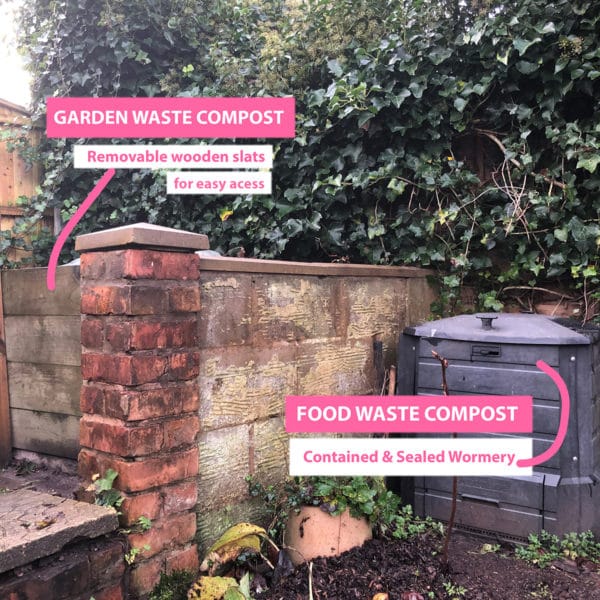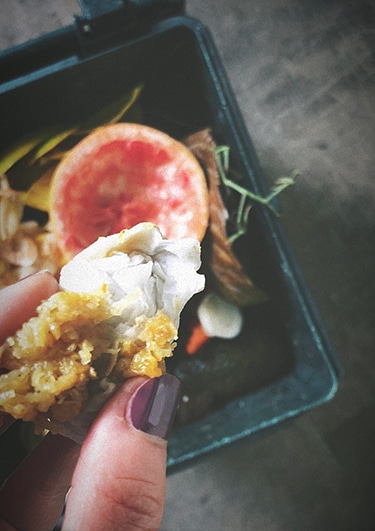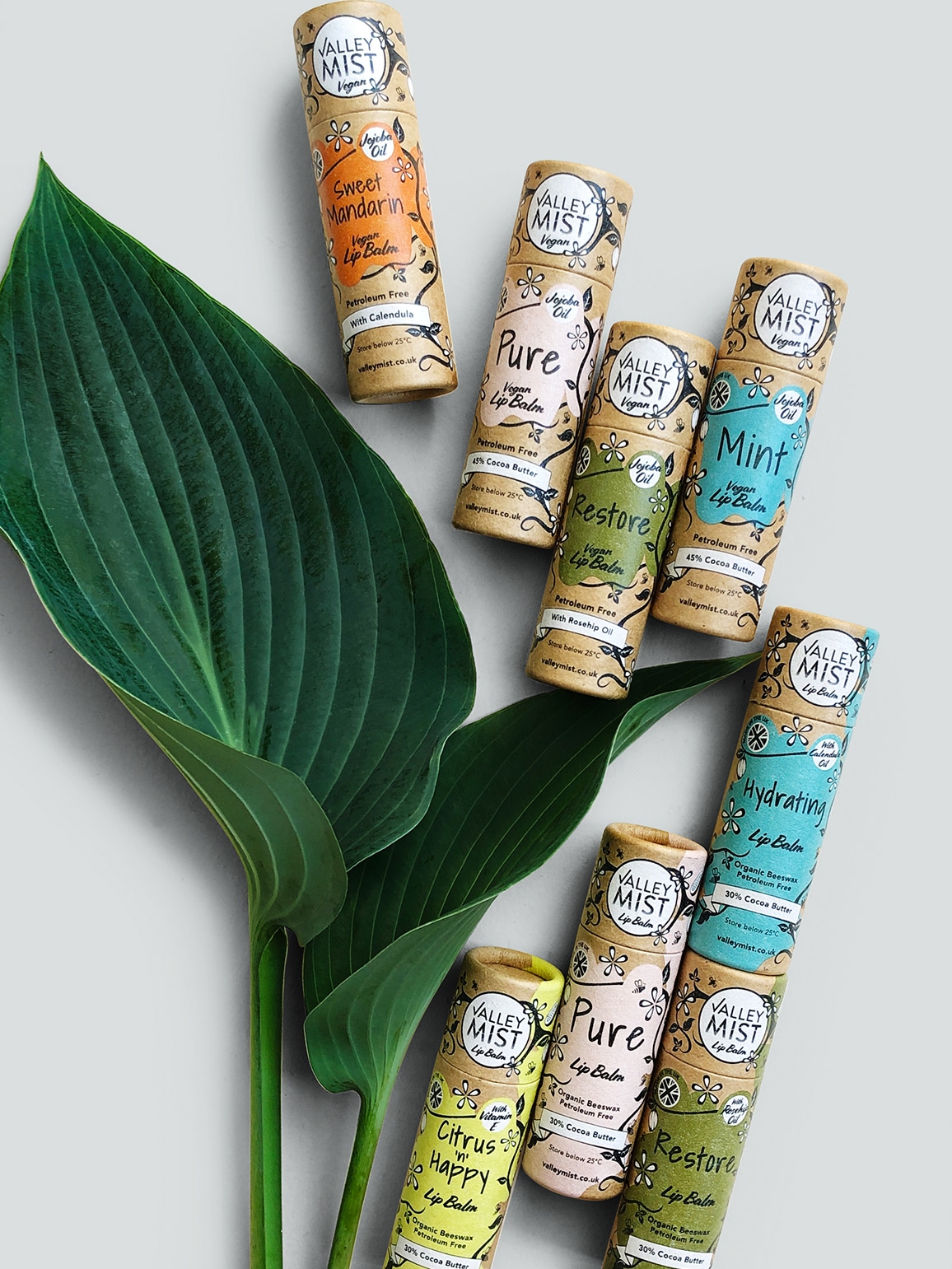
If you have met me over the years at the many events I have been to you’ll probably have been surprised to hear me talk about composting! It’s likely that I will have talked about compost just as much as about Valley Mist skincare, if not more. Composting is a big subject at Valley Mist HQ and Mr Valley Mist in particular gets super animated when he talks compost.
So it is no surprise that our launch products were the much loved Valley Mist lip balms in degradable paper tubes.
Why is composting important?
Throwing away our organic waste means we are unecessarily choking up rubbish removal trucks and landfill that could be otherwise used for truly non recyclable waste. Even if you are trying to do the right thing and are putting compostible waste into a ‘brown bin’ for removal by the council then this still requires the uneccessary use of fuel, energy, space and resources to transport the waste from a to b for composting. With a little bit of effort you can cut out the middle man and produce compost right at home.
What can we compost?
Any organic waste from your garden or your kitchen can be composted, even cooked food although you need to be careful how you do that otherwise you may be at risk of attracting vermin.

Global warming and climate change.
Aside from the unecessary waste of resources that having compostible matter removed from our homes causes, we also add to the cloud of emissions that are potentially released from landfill sites. Although modern landfil sites manage and ideally utilise their emissions, the anaerobic ‘soup’ at the bottom of a landfil produces huge amounts of methane as organic matter decomposes and, if emissions escape which they inevitably will, then methane emissions are reportedly far more harmful and more potent to the environment than Co2! A good home compost heap decomposes waste aerobically which avoids the release of such harmful gases.
So innocently people throw their food scraps in the bin not realising those bits add up to a potentially huge contribution to global warming. I didn’t know this until quite recently too.
Types of composting you could give a try
Food waste
Invest in a storage caddy for your kitchen worktop or floor which can be used to collect all organic food waste from your house. You’ll also need a wormery; either invest in one or, better still, prod someone handy in the family into making one. Don’t be put off by all the unecessarily complicated nonsense that you read on the internet about wormeries. There are only a very few key requirements for a basic wormery which are that it needs to be vermin proof, big enough to take the amount of organic waste your kitchen produces along with equal quantities of card board (the more basic brown and unprinted the better which your household is also likely to have plenty of given the era of internet shopping and home delivery that we live in). The wormery should ideally open bottomed and placed straight onto soil where you can just bury the edges to avoid attracting any unwanted visitors. If you meet these three requirements trust me, the worms and other critters that exist for the sole purpose of breaking your organic waste down and turning it into plant growing rocket fuel will arrive of their own accord and get right to work.
But Euwww!? …. honestly, it’s not as bad as it sounds!
If you really don’t like the idea or just don’t have the space for a wormery, then start with some sort of sealed storage caddy. There are a number of local initiatives where you can register for food waste collection service. Recycle Now have a fantastic page on their website where you can directly check if there is a food waste collection service in your area.
Garden waste
If you’re lucky enough to have a garden then it is likely, even if you’re an advocate of letting it run wild as much as possible, that it produces waste in some form or other (trimmings, cuttings, deadfalls, mowings etc.). The same simple rule applies to composting garden waste as food waste. If it’s organic, it can go in! Unbelievably though, there are still so many people that will stuff all that potential goodness into a brown bin and pay for the council to take it away. This effectively breaks the nutrient cycle of your garden, taking away from the system but not putting back in .. or worse still, putting back in using petrochemical derived fertilisers in a futile and unsustainable attempt to fix the broken nutrient cycle! All it takes to close the loop on the cycle is to set aside a small space, again in a size appropriate to the quantity of waste produced this time by your garden instead of your kichen, to create a compost heap.
There are a multitude of ways to manage and create compost, many of which may seem overcomplicated or just plain hard work and put you off before you start. There are only a few basic requirements for a compost heap that you need to understand to make it work. The preferred method at Valley Mist HQ is the ‘lasagna’ method of just layering waste on your heap as and when it comes to hand which takes as little work as stuffing the same waste into a brown bin! The basic rules .. try and balance out the input of greens and browns (see below for what that means) but don’t be clenched about it; if it’s a choice between a brown bin or the heap, always choose the heap! Try and chop things up as much as you can, the smaller the better but chopping takes time so find your balance.
So you if you have the space and you’re keen to give it a go then go for it .. you can’t go too far wrong and nature will get on with the job regardless of your best efforts to get in its way! If you get a half decent balance of greens and browns you’ll be amazed at how quickly a seemingly overflowing compost heap will start to break down and reduce in volume, making space for the next layers of the lasagna. Note that the whole process generally speeds up in the Summer with warmth and slows right down in the Winter with cold, but that mirrors the speed of compost heap inputs produced by the garden throughout the seasons.
The above describes composting in its most simplistic form to try and get you enthused about it and maybe inspired to have a go. Like all things in life these days, there are nerdy depths to this subject that could give you the bends if you dive in too deep too quickly .. turning and aeration; moisture content; aerobic vs. anaerobic and heap core temperature for degredation of pathogens and weed seeds etc. etc. .. but we don’t want to bore anyone or put off a potential convert! Dig deeper (pun definitely intended) if you’re interested, but if not just stick to the above basics, either way the important thing is to have a go.
Key Ingredients of Compost
Carbon.
Carbon rich materials are generally known as ‘browns’ and include twigs and branches, anything dead or dried (including leaves and grass) and, if necessary cardboard or paper (preferably not bleached paper or glossy printed magazines). Using carbon as the fuel that keeps your compost cooking and adds bulk and structure to the mix. General guidance the smaller the particle size the better i.e. chipped or shredded best but generally chopped, torn, snapped, smashed, broken is better than whole. Trust me, if you stick a tree branch in your compost heap, it’ll still be a tree branch even after a couple of years .. but even then the process of decomposition will have started! Compost heaps are magical performers of alchemy but they don’t work miracles.
The alternative for the bigger lumps like rootballs / the trunk of your dead Christmas tree etc. is to create a ‘habitat stack’ for bigger garden critters to make a home in. Again this takes space but nature loves a tangled mess over manicured perfection so make your garden inviting and give up a hidden corner for a stack!
Nitrogen.
Nitrogen rich materials are generally known as ‘greens’ and include freshly mown grass, green leaves and plants (compost super charger greens are plants like comfrey or pea plants and roots which are all stuufed with nitrogen), but even your own or a pet’s hair is a source! Remember if something is organic it’s a resource and never ‘waste’! Greens are an essential part of the composting process and nitrogen is one of the three key nutrients that all plants require to grow and be healthy – nitrogen (N), phosphorus (P) and potassium (K).
Oxygen.
Let it breathe. Without oxygen the process of composting will stall or become anaerobic. Keep the heap loose and try not to compact it too much to allow air to get in. If you want to get more involved create air ways into the centre of the heap with something appropriately long and spikey or, if you want the ultimate core work out get in there with a garden fork and turn it top to bottom and inside to outside. If you do decide to actively aerate BE CAREFUL .. wonderful beasties like hedgehogs are drawn to compost heaps, particularly in Winter to hibernate in, so turn or spike with care!
Moisture.
Composting requires moisture so try not to let your heap become too dry, although if you live in the UK that usually isn’t a great concern. Too much moisture is equally a problem as it hampers the aerobic composting process and your heap may become anaerobic .. soggy, stinky, oozy heaps are a good sign that things have become anaerobic .. if in doubt aerate and add more carbon! Generally if you live somewhere persistently wet then throw an old piece of tarp or roofing felt or similar over the top to prevent saturation (this also helps keep heat in which helps the composting process, and remember that the ingredients themselves have varying moisture content with greens generally being much higher than browns so as with all of the above, try and find that balance.
Feeling Inspired?
We hope you have found this information interesting. Saving our planet needs to be more about or day to day micro actions. Buying non plastic products is agood start but we all know we need a whole new approach to the way we live. Composting can be an easy place to begin without spending any money at all if you have the space.












